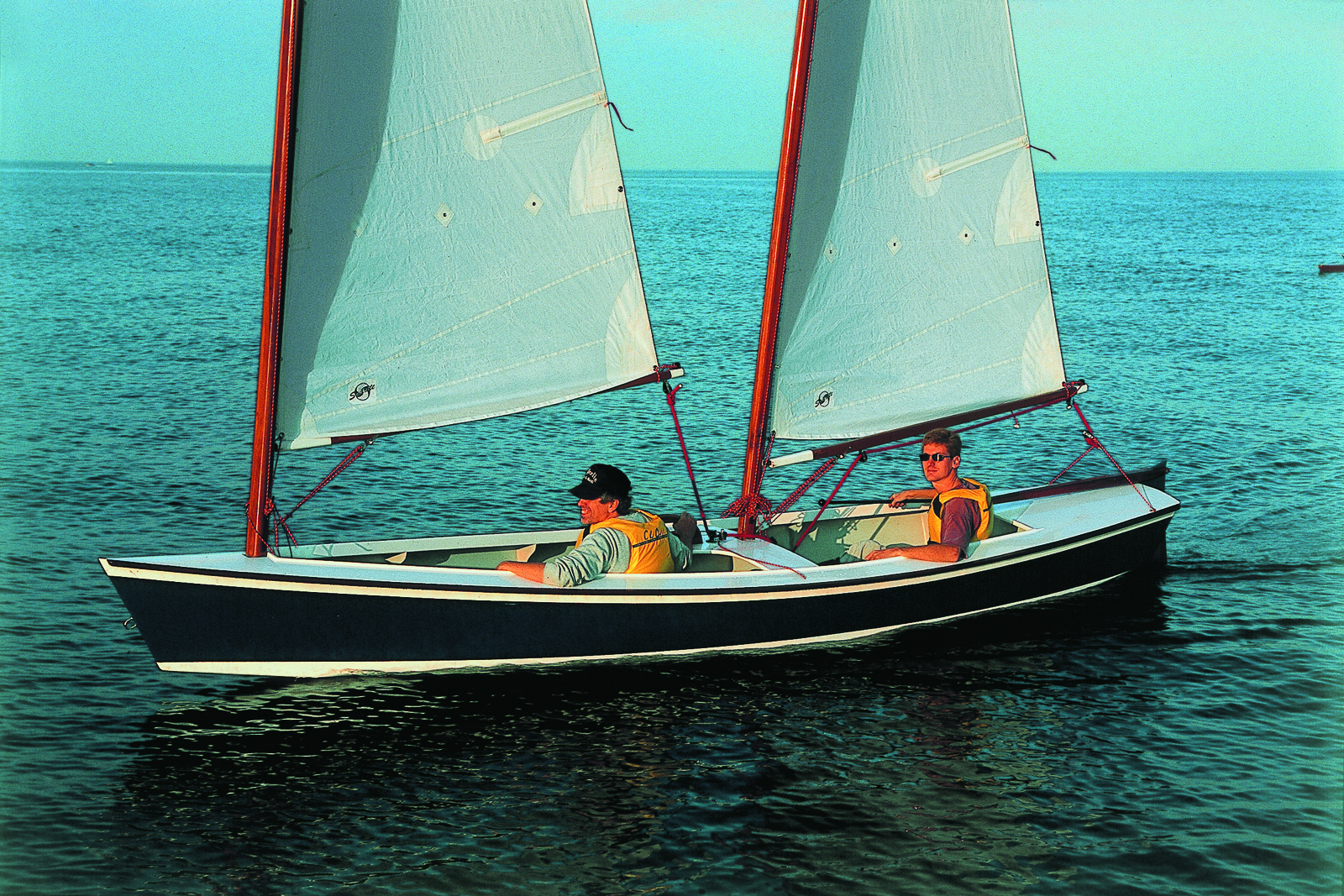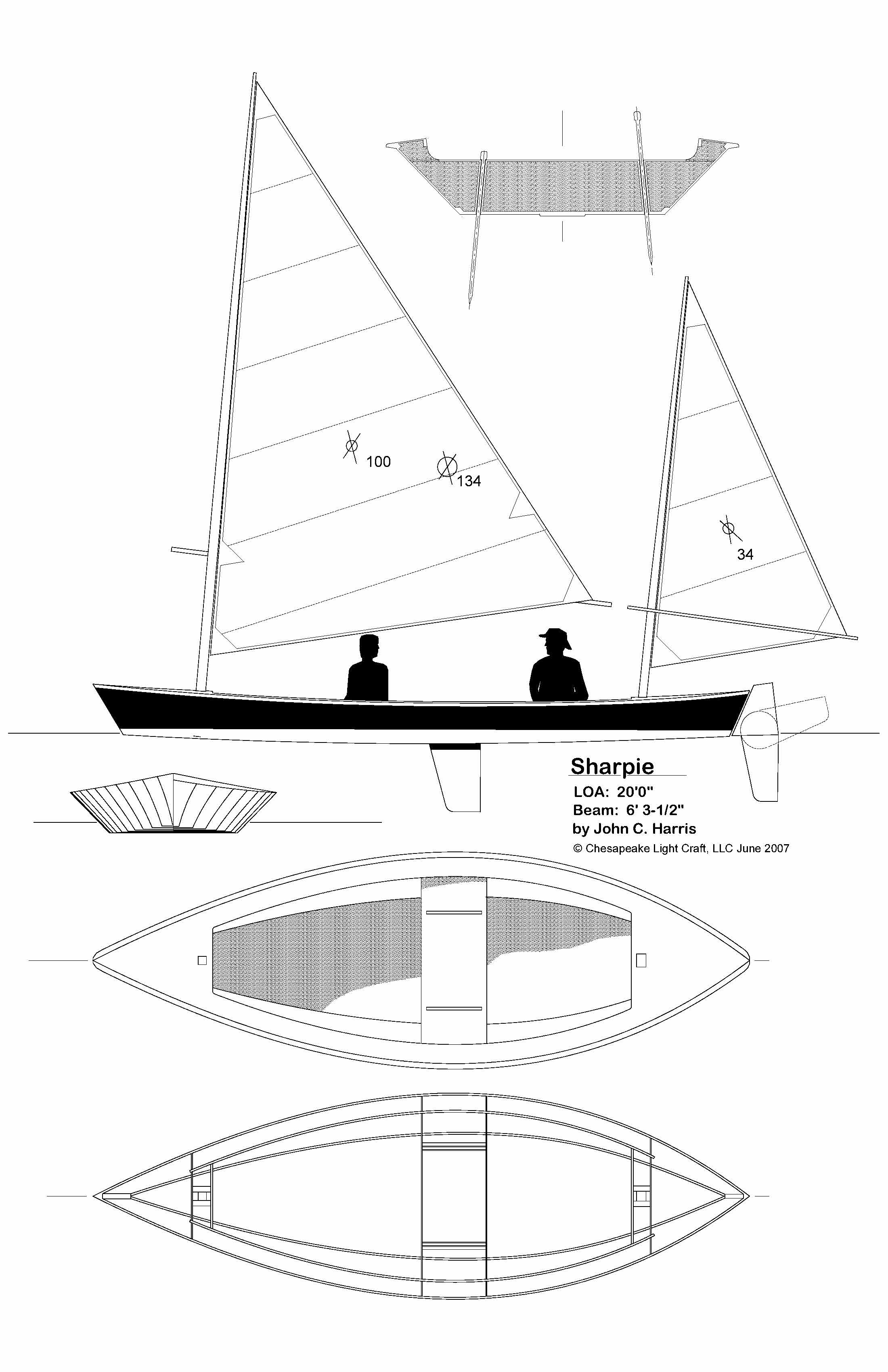The Sharpie That Got Away
By John C. Harris
May 2020
 |
| The 20-foot sharpie I drew for Bill and Matt. |
In 2007 my colleagues Bill and Matt, father and son, were looking for a daysailer to build as an evening project. They suggested that a sharpie would be fun. A sharpie is a flat-bottomed sailboat with a single chine, usually fairly narrow. We had such a boat in the catalog, of course, the unimaginatively named John's Sharpie. "Hold on," I said. "I've got something new on the drawing board."
John's Sharpie was a project stretching back almost 25 years, one of the first sailboats in CLC's catalog. She's a fast and handy boat, with handsome proportions. She's also cranky and requires an alert skipper to keep her upright, a quirk that's at odds with the otherwise classical sharpie lines. She's a 200-pound racing dinghy disguised as an 1880's oyster-tonging boat.
John's Sharpie is like that because 25 years ago, all I really cared about was going fast. There's another interesting reason for her skinny waterline: the width of a sheet of plywood. In the northern hemisphere plywood is mostly 48 inches (122cm) wide. Keeping the bottom four feet wide, to get it out of a single width of plywood, lowers costs and speeds construction.
The upshot is a skinny 18-foot sailboat.
 |
| John's Sharpie Hull #1 in about 1997. |
 |
| John's Sharpie is a cat-ketch. It's an optical illusion that the mizzen is smaller. In fact, main and mizzen masts, booms, and sails are exactly identical. It's a big rig for a light, narrow boat. She'd do pretty well with half that sail area... |
I'd been doodling variations on the John's Sharpie design for years, of course. John's Sharpie appealed most to builders who wanted a relaxing daysailer, so the trick was to detune the design just the right amount.
 |
| A freehand sketch from the early 2000's. While design at CLC had long since gone digital, pen and ink was how I created renderings in those days. |
The sketch above shows the evolution towards the cat-yawl that Bill and Matt eventually built. I was still fixed on keeping the bottom no wider than a sheet of plywood, but stability has been enhanced by flaring the sides sharply, like a dory. The single daggerboard shown here results in a deep sailing draft, and no one really wanted to have to build the trunk-rudder.
 |
| The 20-foot sharpie I drew for Bill and Matt. Same four-foot-wide bottom, but lots of flare in the sides for strong secondary stability. |
We compromised with a pair of shallower daggerboards and a conventional kick-up rudder hung on the stern.
It's usually my habit to give sailboats a deeper swoop to the sheer, but I'd imposed an arbitrary limitation: the side panels could be no wider than 24", so that two side panels would fit on a 4x8 sheet of plywood. This limited the design to the sheerline shown. The boat looks curvier in three dimensions than it does in the drawings.
 |
| Bottom panels are no wider than 48", and side panels are no wider than 24". Decks and sailing components aren't shown, but I've done worse than nine sheets for a 20-foot boat... The panel layout, the schematic above, and some notes on spars comprise all the drawing work completed on the boat. IE, there are no plans available. |
We zipped the parts out on the CNC machine and Bill and Matt got building. My flared sides required a lot of twist in the side panels. Turns out I'd pressed right up to the limits of what you could do stitch-and-glue style, without a building jig. Coaxing those side panels to come together at the stems required several evenings of wrestling. It took straps, cleats, purchases, and plenty of profanity. At a stroke, the "New Sharpie" (the design never got a name) was disqualified as a proposition for first-time boatbuilders.
 |
| Pulling the sides together in a hull with so much flare amidships required a heroic struggle. It's a shape that should have been built atop a traditional mold. |
Having persevered, the rest of construction was straightforward cut-and-fit joinery.
 |
| Bill opens up one of the twin daggerboard slots. The bottom is thick and heavy, to reduce the need for framing, and to function as ballast. |
 |
| The center compartment houses the twin daggerboards, and a built-in cooler. |
Most of the interior was installed, and Bill and Matt began assembling a beautiful hollow "birds-mouth" spar for the mainmast. That was the state of things in about 2008. Life happened; Matt got married and presently had two beautiful kids. Bill was ready to retire (for a second time) and was getting busy with the grandkids.
For my part, I'd fumbled in trying to specify stitch-and-glue construction for a shape that should have been built over a mold. Yet if I was going to go to the trouble of building a mold, I'd have drawn a different hull shape... Thus the new sharpie became another orphan design. Eventually I'll fill this blog with the designs of mine that got started but never launched.
The unfinished hull remains in storage here at CLC, awaiting a new owner. Whenever I wander by I take a long, critical look. She's attractive, functional, and will be a fun, relaxing sailboat for whoever gets around to finishing her.


 return to section:
return to section: 










